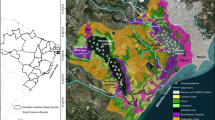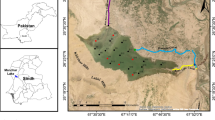Abstract
Given the importance of colored dissolved organic matter (CDOM) for the structure and function of lake ecosystems, a method that could estimate the amount of CDOM in lake waters over large geographic areas would be highly desirable. Satellite remote sensing has the potential to resolve this problem. We carried out model simulations to evaluate the suitability of different satellite sensors (Landsat, IKONOS, and the Advanced land Imager [ALI]) to map the amount of CDOM in concentration ranges that occur in boreal lakes of the Nordic countries. The results showed that the 8-bit radiometric resolution of Landsat 7 is not adequate when absorption by CDOM at 420 nm is higher than 3 m−1. On the other hand, the 16-bit radiometric resolution of ALI, a prototype of the next generation of Landsat, is suitable for map** CDOM in a wider range of concentrations. An ALI image of southern Finland was acquired on 14, July 2002 and in situ measurements were carried out in 15 lakes (18 stations). The results showed that there is a high correlation (R2 = 0.84) between the 565 nm/660 nm ALI band ratio and the CDOM absorption coefficient in lakes. Analysis of 245 lakes in the acquired satellite image showed a normal distribution of CDOM concentration among the lakes. However, the size distribution of lakes was highly skewed toward small lakes, resulting in the CDOM concentration per unit lake area being skewed toward high values. We showed that remote sensing enables synoptic monitoring of the CDOM concentration in a large number of lakes and thus enables scaling up to the level of large ecosystems and biomes.







Similar content being viewed by others
References
Arenz RF, Lewis WM, Saunders JF. 1996. Determination of chlorophyll and dissolved organic carbon from reflectance data for Colorado reservoir. Int J Remote Sens 17:1547–66
Arst H. 2003. Optical properties and remote sensing of multicomponental water bodies. Berlin: Springer-Praxis. p 231
Cole JJ, Caraco NF, Kling GW, Kratz TK. 1994. Carbon dioxide supersaturation in the surface waters of lakes. Science 265:1568–70
Curtis PJ. 1998. Climatic and hydrologic control of DOM concentration and quality in lakes. In: Hessen DO, Tranvik LJ, editors. Aquatic humic substances; vol 133. Berlin: Springer-Verlag. p 93–104
Dekker AG. 1993. Detection of water quality parameters for eutrophic waters by high resolution remote sensing [dissertation]. Amsterdam: Free University
Erm A, Arst H, Nõges P, Nõges T, Reinart A, Sipelgas L. 2002. Temporal variations in bio-optical properties of four north Estonian lakes in 1999–2000. Geophysica 38:89–111
Freeman C, Evans CD, Monteith DT, Reynolds B, Fenner N. 2001. Export of organic carbon from peat soils. Nature 412:785.
Gordon HR, Brown OB, Evans RH, Brown JW, Smith RC, Baker KS, Clark DK. 1988. A semianalytical radiance model of ocean color. J Geophys Res 93(D9):10909–24
Hirtle H, Rencz A. 2003. The relation between spectral reflectance and dissolved organic carbon in lake water: Kejimkujik Park, Nova Scotia, Canada. Int J Remote Sens 24:953–67
[ISO] International Organization for Standardization. 1992. Water quality — measurement of biochemical parameters — spectrometric determination of the chlorophyll-a concentration, ISO method 10260:1992. Geneva: International Organization for Standardization. Available online at: http://www.iso.org
[ISO] International Organization for Standardization. 1994. Water quality: examination of water color. European Committee for Standardization, Brussels
Jansson M. 1998. Nutrient limitation and bacteria-phytoplankton interactions in humic lakes. In: Hessen D, Tranvik L, editors. Aquatic humic substances: ecology and biogeochemistry. Ecological Studies; vol. 133. Berlin: Springer-Verlag. p 177–95
Jansson M, Bergström A-K, Blomqvist P, Drakare S. 2000. Allochthonous organic carbon and phytoplankton/bacterioplankton production relationships in lakes. Ecology 81:3250–5
Jones RI. 1998. Phytoplankton, primary production and nutrient cycling. In: Hessen D, Tranvik L, editors. Aquatic humic substances: ecology and biogeochemistry. Ecological Studies; vol. 133. Berlin: Springer-Verlag. p 145–75
Kallio K. 1999. Absorption properties of dissolved organic matter in finnish lakes. Proc. Estonian Acad. Sci. Biol. Ecol. 48:75–83
Kallio K, Kutser T, Hannonen T, Koponen S, Pulliainen J, Vepsäläinen J, Pyhälahti T. 2001. Retrieval of water quality from airborne imaging spectrometry of various lake types in different seasons. Sci Total Environ 268:59–77
Kirk JTO. 1984. Dependence of relationships between inherent and apparent optical properties of water on solar altitude. Limnol Oceanogr 29:350–6
Kirk JTO. 1994. Light and photosynthesis in aquatic ecosystems. Melbourne: Cambridge University Press
Kortelainen P,. 1993. Content of total organic carbon in Finnish lakes and its relationship to catchment characteristics. Can J Fish Aquat Sci 50:1477–83
Kutser T, Arst H, Mäekivi S, Kallaste K. 1998. Estimation of the water quality of the Baltic Sea and lakes in Estonia and Finland by passive optical remote sensing measurements on board vessel. Lakes & Reservoirs: Res and Manag 3:53–66.
Kutser T, Herlevi A, Kallio K, Arst H. 2001. A hyperspectral model for interpretation of passive optical remote sensing data from turbid lakes. Sci Total Environ 268:47–58
McKnight DM, Aiken GR. 1998. Sources and age of aquatic humus. In: Hessen DO, Tranvik LJ, editors. Aquatic humic substances; vol 133. Berlin: Springer-Verlag. p. 9–39
Molot LA, Dillon PJ. 1997. Photolytic regulation of dissolved organic carbon in northern lakes. Global Biogeochem Cycles 11:357–65
Moran MS, Bryant R, Thome K, Nouvellon WNY, Gonzales-Dugo MP, Qi J, Clarke TR. 2001. A refined empirical line approach for reflectance factor retrieval from Landsat-5 TM and Landsat-7 ETM+. Remote Sens Environ 78:71–82
Mulholland PJ. 2003. Large-scale patterns in dissolved organic carbon concentrations, flux, and sources. In: Findlay SEG, Sinsabaugh RL, Eds. Aquatic ecosystems: interactivity of dissolved organic matter. Academic Press. p 139–59
Norrman B. 1993. Filtration of water samples for DOC studies. Mar Chem 41:239–42
Pace ML, Cole JJ. 2002. Synchronous variation of dissolved organic carbon and color in lakes. Limnol Oceanogr 47:333–42
Pierson DC, Strömbeck N. 2000. A modeling approach to evaluate preliminary remote sensing algorithms: use of water quality data from Swedish Great Lakes. Geophysica 36:177–202
Pierson DC, Strömbeck N. 2001. Estimation of radiance reflectance and concentrations of optically active substances in Lake Mälaren, Sweden, based on direct and inverse solutions of a simple model. Sci Total Environ 268:171–89
Prairie YT, Bird DF, Cole JJ. 2002. The summer metabolic balance in the epilimnion of southeastern Quebec lakes. Limnol Oceanogr 47:316–21
Raatikainen M, Kuusisto E. 1990. The number and surface area of lakes in Finland [in Finnish with English abstract]. Terra 102:97–110
Rasmussen JB, Godbout L, Schallenberg M. 1989. The humic content of lake water and its relationship to watershed and lake morphometry. Limnol Oceanogr 34:1336–43
Sathyendranath S, Prieur L, Morel A. 1989. A three-component model of ocean color and its application to remote sensing of phytoplankton pigments in coastal waters. Int J Remote Sens 11:1373–94
Sipelgas L, Kallio K, Arst H, Erm A, Oja P, Soomere T. Optical properties of dissolved organic matter in Finnish and Estonian lakes. Nordic Hydrol. 34: 361–386
Sobek S, Algesten G, Bergström A-K, Jansson M, Tranvik LJ. 2003. The catchment and climate regulation of pCO2 in boreal lakes. Global Change Biol 9:630–41
Strömbeck N. 2001. Water quality and optical properties of Swedish lakes and coastal waters in relation to remote sensing [dissertation]. Uppsala (Sweden): University of Uppsala
Strömbeck N, Pierson DC. 2001. The effects of variability in the inherent optical properties on estimations of chlorophyll a by remote sensing in Swedish freshwaters. Sci Total Environ 268:123–38
Department of Environmental Assessment. 2000. Swedish Agricultural University, Swedish national lake monitoring. Available online at: http://www.info1.ma.slu.se/ri/www_ri.acgi$Project?ID=2000KS
Tranvik LJ,. 1990. Bacterioplankton growth on fractions of dissolved organic carbon of different molecular weights from humic and clear waters. Appl Environ Microbiol 56:1672–7
Tranvik LJ,. 1992. Allochthonous organic matter as an energy source for pelagic bacteria and the concept of the microbial loop. Hydrobiology 229:107–14
Tranvik LJ, Jansson M. 2002. Climate change and terrestrial export of organic carbon. Nature 415:861–2
Vertucci FA, Likens GE. 1989. Spectral reflectance and water quality of Adirondack mountain region lakes. Limnol Oceanogr 34:1656–72
Acknowledgment
This work was supported by the Swedish Research Council for Environment, Agricultural Sciences, and Spatial Planning (FORMAS).
Author information
Authors and Affiliations
Corresponding author
Rights and permissions
About this article
Cite this article
Kutser, T., Pierson, D.C., Tranvik, L. et al. Using Satellite Remote Sensing to Estimate the Colored Dissolved Organic Matter Absorption Coefficient in Lakes. Ecosystems 8, 709–720 (2005). https://doi.org/10.1007/s10021-003-0148-6
Received:
Accepted:
Published:
Issue Date:
DOI: https://doi.org/10.1007/s10021-003-0148-6




